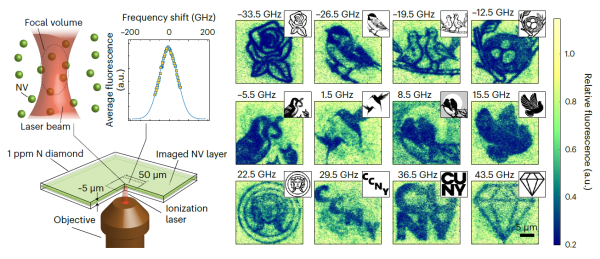
Protocol for charge state control of color centers in a high-density sample. CCNY researchers address sub-ensembles of atoms at the same spot but at different frequencies to imprint 12 images at the same location. Credit: Nature Nanotechnology.
Physicists at The City College of New York have developed a technique with the potential to enhance optical data storage capacity in diamonds. This is possible by multiplexing the storage in the spectral domain. The research by Richard G. Monge and Tom Delord members of the Meriles Group in CCNY’s Division of Science, is entitled “Reversible optical data storage below the diffraction limit” and appears in the journal “Nature Nanotechnology.”
“It means that we can store many different images at the same place in the diamond by using a laser of a slightly different color to store different information into different atoms in the same microscopic spots,” said Delord, postdoctoral research associate at CCNY. “If this method can be applied to other materials or at room temperature, it could find its way to computing applications requiring high-capacity storage.”
The CCNY research focused on a tiny element in diamonds and similar materials, known as “color centers.” These, basically, are atomic defects that can absorb light and serve as a platform for what are termed quantum technologies.
“What we did was control the electrical charge of these color centers very precisely using a narrow-band laser and cryogenic conditions” explained Delord. “This new approach allowed us to essentially write and read tiny bits of data at a much finer level than previously possible, down to a single atom.”
Optical memory technologies have a resolution defined by what's called the "diffraction limit," that is, the minimum diameter that a beam can be focused to, which approximately scales as half the light beam wavelength (for example, green light would have a diffraction limit of 270 nm). “So, you cannot use a beam like this to write with resolution smaller than the diffraction limit because if you displace the beam less than that, you would impact what you already wrote. So normally, optical memories increase storage capacity by making the wavelength shorter (shifting to the blue), which is why we have "Blu-ray" technology,” said Delord.
What differentiates the CCNY optical storage approach from others is that it circumvents the diffraction limit by exploiting the slight color (wavelength) changes existing between color centers separated by less than the diffraction limit. “By tuning the beam to slightly shifted wavelengths, it can be kept at the same physical location but interact with different color centers to selectively change their charges -- that is to write data with sub-diffraction resolution,” said Monge, a postdoctoral fellow at CCNY who was involved in study as a PhD student at the Graduate Center, CUNY.
Another unique aspect of this approach is that it’s reversible. “One can write, erase, and rewrite an infinite number of times,” Monge noted. “While there are some other optical storage technologies also able to do this, this is not the typical case, especially when it comes to high spatial resolution. A Blu-ray disc is again a good reference example -- you can write a movie in it but you cannot erase it and write another one.”
About The City College of New York
Since 1847, The City College of New York has provided a high-quality and affordable education to generations of New Yorkers in a wide variety of disciplines. CCNY embraces its position at the forefront of social change. It is ranked #1 by the Harvard-based Opportunity Insights out of 369 selective public colleges in the United States on the overall mobility index. This measure reflects both access and outcomes, representing the likelihood that a student at CCNY can move up two or more income quintiles. Education research organization Degree Choices ranks CCNY #1 nationally among universities for economic return on investment. In addition, the Center for World University Rankings places CCNY in the top 1.8% of universities worldwide in terms of academic excellence. Labor analytics firm Emsi (now Lightcast) puts at $1.9 billion CCNY’s annual economic impact on the regional economy (5 boroughs and 5 adjacent counties) and quantifies the “for dollar” return on investment to students, taxpayers and society. At City College, more than 15,000 students pursue undergraduate and graduate degrees in eight schools and divisions, driven by significant funded research, creativity and scholarship. This year, CCNY launched its most expansive fundraising campaign, ever. The campaign, titled “Doing Remarkable Things Together” seeks to bring the College’s Foundation to more than $1 billion in total assets in support of the College mission. CCNY is as diverse, dynamic and visionary as New York City itself. View CCNY Media Kit.
Jay Mwamba
p: 917.892.0374
e:
jmwamba@ccny.cuny.edu